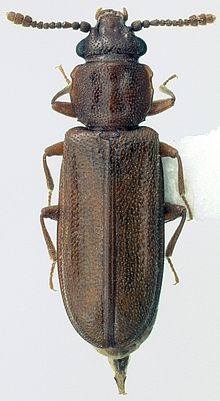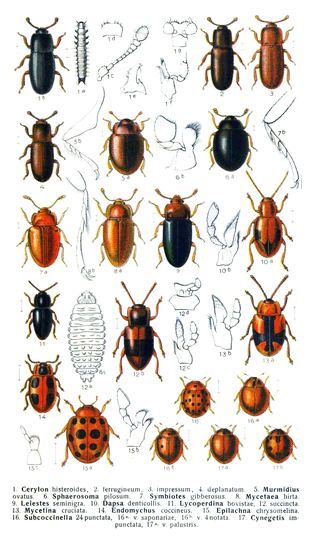
Cucujoidea is a superfamily of beetles. This group formerly included all of the families now included in the superfamily Coccinelloidea. They include some fungus beetles and a diversity of lineages of "bark beetles" unrelated to the "true" bark beetles (Scolytinae), which are weevils.
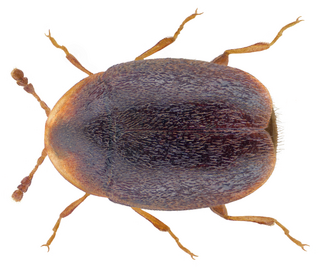
Corylophidae is a family of minute hooded beetles, sometimes called minute fungus beetles, in the superfamily Coccinelloidea. There are about 18 genera and at least 120 described species in Corylophidae. They feed on microfungi such as molds, and are often found associated with bark, as well as in leaf litter and other decaying vegetation. In older literature, the family name was often given as Orthoperidae.

Cucujus cinnaberinus is a species of beetles in the family Cucujidae, the flat bark beetles. It is native to Europe, being most common in Central Europe and rare in much of Southern and Western Europe.
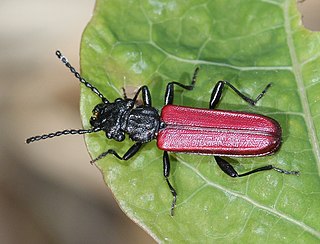
Cucujus is a genus of beetles in the family Cucujidae, the flat bark beetles. It contains 19 currently recognized species and subspecies.
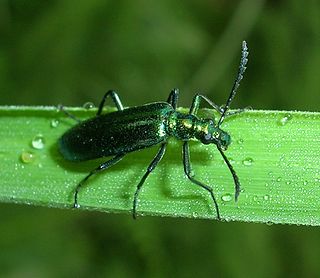
Prionoceridae is a small family of beetles, in the suborder Polyphaga. They form a group within the cleroid beetles and were formerly treated as a subfamily (Prionocerinae) within the family Melyridae. Very little is known of their life history but most species are pollen feeders as adults and occur in large numbers during spring or the host flowering season. Larvae are predatory or feed on decomposing wood.

Laemophloeidae, "lined flat bark beetles," is a family in the superfamily Cucujoidea characterized by predominantly dorso-ventrally compressed bodies, head and pronotal discs bordered by ridges or grooves, and inverted male genitalia. Size range of adults is 1–5 mm (0.04–0.2 in) in length. Currently, it contains 40 genera and about 450 species, and is represented on all continents except Antarctica; species richness is greatest in the tropics.

Silvanidae, "silvan flat bark beetles", is a family of beetles in the superfamily Cucujoidea, consisting of 68 described genera and about 500 described species. The family is represented on all continents except Antarctica, and is most diverse at both the generic and species levels in the Old World tropics.
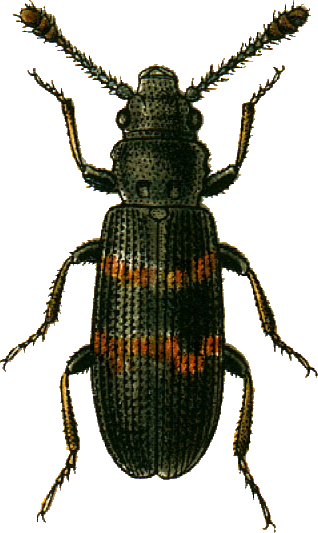
Phloeostichidae is a family of beetles in the superfamily Cucujoidea. They are typically found under the bark of dead trees. Larvae have been found to consume plant tissue and some fungi, while the adults appear to be exclusively fungivores. The family contains four extant genera, Phloeostichus is native to the Palearctic, Rhopalobrachium is native to central-southern South America and eastern Australia, Hymaea is native to southeastern Australia, and Bunyastichus is found in Tasmania.
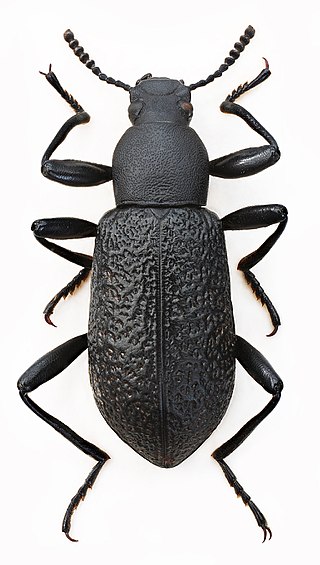
Upis ceramboides is a species of beetle, one of many wood-living insects that benefit from forest fires. It often occurs in quantities below the bark on the fire-damaged birches, but can sometimes be seen on other deciduous trees such as willow and aspen. The larvae thrive in the inner bark which is rich in mycelia, and in the sapwood. They develop into pupae during the summer months under the bark, and they develop over two or three years. The following spring they reproduce themselves.

Passandridae, the "parasitic flat bark beetles," are a family of beetles notable for being one of the very few beetle families with larvae that are, as far as known, exclusively ectoparasitic on the immature stages of other beetles and Hymenoptera.

Palaestes is a genus of beetles in the family Cucujidae. It contains eight currently recognized species. Like all members of the Cucujidae, adults are greatly dorso-ventrally compressed. All known species of Palaestes are brightly colored red or yellow and black, and the males have curiously modified mandibles that look like ice tongs; female mandibles are not modified. Palaestes shares with the Australian-New Zealand genus Platisus the character of the male genitalia, which lacks a flagellum, lying on its side in the abdomen, versus inverted in Cucujus and Pediacus.

Pediacus is the largest genus in the family Cucujidae of flat bark beetles. It contains 31 currently recognized species. Pediacus adults are relatively small (2.7-7.0mm), flattened brownish beetles with no or very small temples, and short antennae with a distinct club. Male genitalia are inverted and possess a short flagellum.

Cucujus clavipes is known as the flat bark beetle. It is found throughout North America. These are generally found near tree line under bark of dead poplar and ash trees. C. clavipes are described as phloem-feeding and often predators of other small insects, such as wood-boring beetles, and mites. These are usually seen during spring-summer seasons. Having a cold habitat, these beetles must go through several physiological mechanisms to survive; they are recognised for their ability to change their overwintering mechanisms.

Pediacus depressus is a species of flat bark beetle in the family Cucujidae. It is found in Europe and Northern Asia.
Pediacus ommatodon is a species of flat bark beetle in the family Cucujidae. It is found in North America.

Pediacus subglaber is a species of flat bark beetle in the family Cucujidae. It is found in North America.
Pediacus stephani is a species of flat bark beetle in the family Cucujidae. It is found in North America.
Pediacus andrewsi is a species of flat bark beetle in the family Cucujidae. It is found in North America.

Myrabolia is the only genus in the beetle family Myraboliidae in the superfamily Cucujoidea. It has about 13 species, found in Australia. Adults and possibly larvae live under the bark of Eucalyptus trees.

Peltis is a genus of beetles found in North America and Europe, and the sole extant member of the family Peltidae, formerly included in the Trogossitidae. Members of this genus are dark, averaging from brown, to dark brown, to black. They are small, wide, and flat-bodied with wide, ridged elytra. Fossil species of this genus are known from the Eocene aged Florissant Formation of the United States, as well as the Baltic amber of Europe.



